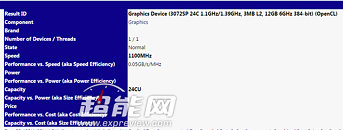Tuesday, November 11th 2014

NVIDIA GeForce GTX TITAN II Detailed
Riding on the success of its GM204 silicon, it looks like NVIDIA won't wait for the 20 nm silicon fab process to build its next big GPU, which powers its enthusiast-segment graphics cards. The GM200 silicon will be built on the existing 28 nm silicon fab process. Among other SKUs, NVIDIA's next GeForce GTX TITAN product, the GTX TITAN II, could be based on this chip. A curious-looking data entry was submitted from an anonymous source to SiSoft's hardware database, which gives away some rather glaring details of the GM200.
To begin with, the GM200 will be built on the existing 28 nm node, and will feature a die-area of 551 mm². The chip will be based on the "Maxwell" architecture, and feature 3,072 CUDA cores, cushioned by a 3 MB L3 cache. The chip will likely feature a 384-bit wide GDDR5 memory interface, with lossless texture compression algorithms, which work to step up memory bandwidth. The standard memory amount is a staggering 12 GB, double that of the first-generation GTX TITAN. Given how AMD recently gave 8 GB variants of its Radeon R9 290X a coordinated launch, GPU vendors could be seeing a utility in giving their products such massive amounts of video memory, to cope with resolutions such as 4K Ultra HD, and perhaps even 5K 16xHD. The chip features reasonably high clock speeds, with the core running at 1100 MHz, and a staggering 1390 MHz GPU Boost. The memory, however, is clocked at 6.00 GHz.
Source:
Expreview
To begin with, the GM200 will be built on the existing 28 nm node, and will feature a die-area of 551 mm². The chip will be based on the "Maxwell" architecture, and feature 3,072 CUDA cores, cushioned by a 3 MB L3 cache. The chip will likely feature a 384-bit wide GDDR5 memory interface, with lossless texture compression algorithms, which work to step up memory bandwidth. The standard memory amount is a staggering 12 GB, double that of the first-generation GTX TITAN. Given how AMD recently gave 8 GB variants of its Radeon R9 290X a coordinated launch, GPU vendors could be seeing a utility in giving their products such massive amounts of video memory, to cope with resolutions such as 4K Ultra HD, and perhaps even 5K 16xHD. The chip features reasonably high clock speeds, with the core running at 1100 MHz, and a staggering 1390 MHz GPU Boost. The memory, however, is clocked at 6.00 GHz.

32 Comments on NVIDIA GeForce GTX TITAN II Detailed
I do not think they are intending that amount of VRAM for the 4K gaming public, more likely to me the same as before the render crowd and cuda devs.Well remember that is also on a higher bus speed.
Remember that for a lot of researchers and renderers, the Titan is really a poor man's Tesla; with its fully functional FP64 performance, Nvidia is not just targeting the gaming crowd.
Yeah, because GM204 is bigger than GK104 and I expected same here. :)
Will wait to see what Daddy Maxwell is going to be.
Titan
2,688 Cores
GPU Clock 836 MHz
Boost Clock 876 MHz
Titan II
3,072 Cores
GPU Clock 1100 MHz
Boost Clock 1390 MHz
Very impressive. I wonder what the Titan Black II will do if they release one.
For me, I will wait on GM210 as I only use my cards for gaming.
Interestingly will they release professional cards on this GM200, keep the pressure on AMD and their professional aspirations? If they aren't looking to get it into the professional markets this will be tough to get volumes that give "enthusiast" good pricing, but I can see this really shocking the market. It abets Nvidia in substantiating their premium price, should be a good response to whatever AMD brings, with little risk. If AMD does 20nm and HBM their pricing won't great on chips or memory so, Nvidia knows they can stack this with lots of lower cost memory and it makes the professionals happy and gamer will say... we've got ram!
Nvidia has the safe play, AMD a crap shoot (if 20nm/HBM) and they'll need to triumph with the next go around. Even if thier 390X comes with great perf/w and perf/$, if it does or doesn’t best this GM200 in say GTX 980Ti form, Nvidia can just work AMD over on pricing (if they have it in high volumes for professional makets). Kind of where Nvidia had been when they held with 65mn, and AMD went 55nm and 4870.
The other factor is obviously as marketing bullet point, but the 6 GHz memory (rather than the 7 GHz now standard for high end GeForce) would tend to support the hypothesis that the test board is being validated for GPU operation across a range of speeds. Dialling down the memory removes it as a factor for testing the system for stability etc.I sincerely doubt it. Architecture to architecture, the closest analogue to the GM 204 is GK 104, so you'd be comparing the GTX 770 (1536 core, 32 ROP, 128 TMU, 256-bit, 1046MHz core, 1085MHz nominal boost) to the GTX 970 (1664 core, 32 ROP, 104 TMU, 256-bit, 1050MHz core/1178MHz nominal boost). The difference in performance (32% at 1440p) far outstrips the hardware comparison, because the salient differences are amongst other things, core-to-compute unit ratio improvement ( 128:1 instead of 192:1), increased and better organized L2 cache structure, and the use of colour compression.
Concerning all this day of the LEAKS...
It is all speculations... Seriously, I won't believe nvidia will release anything on this 28nm tech node again...
It's still gonna be awesome though. My 780 Ti is an amazing card and this is gonna top it by a considerable margin. Hopefully the latest games at 4K and 120Hz refresh will be a reality with just one card.
I can play the latest games at 1080p 120Hz (often with no dropped frames) on my current PC (see specs) but pushing 4K using DSR really tanks performance, although it may still stay well above 60fps depending on the game and quality settings.
Since last time, they went from four digit numbers to three digit numbers, I guess this will be the Geforce 18? ;)
Eventually bringing us back to the Geforce 1 after a few more generations.